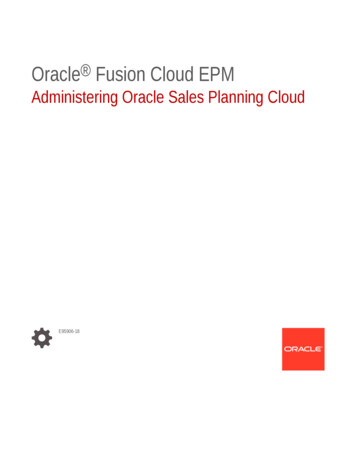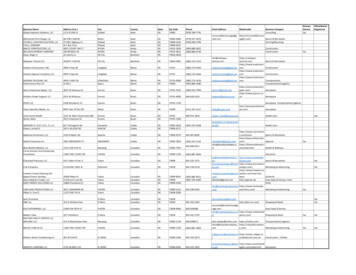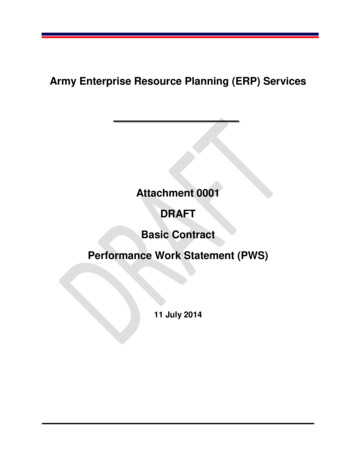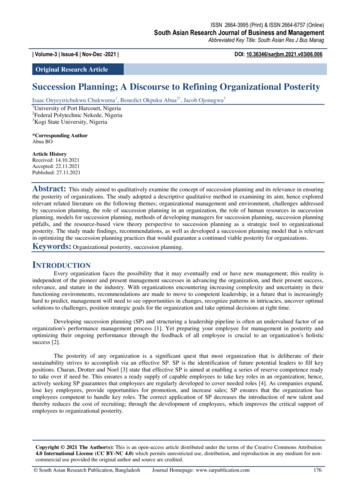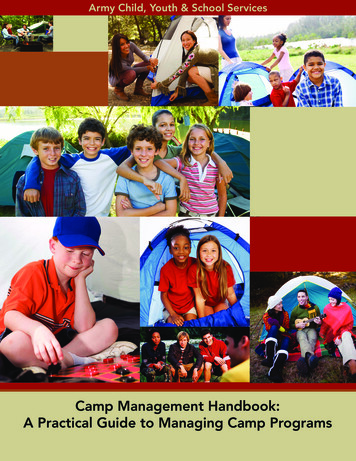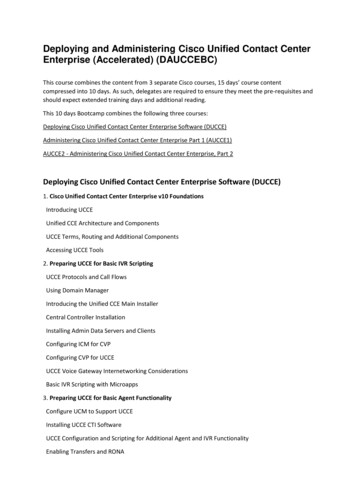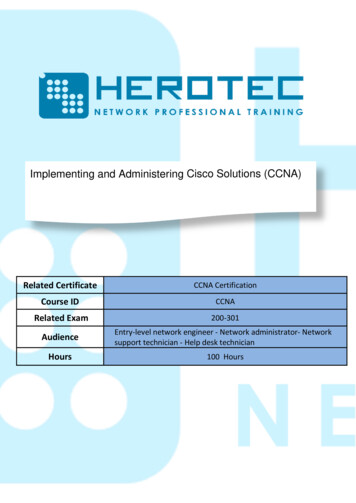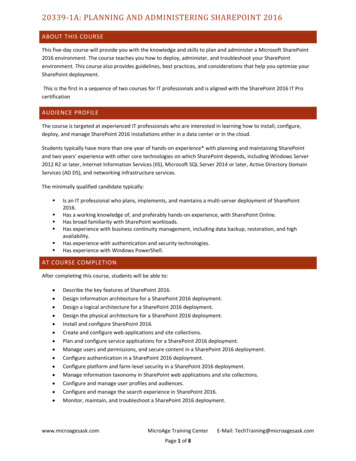
Transcription
20339-1A: PLANNING AND ADMINISTERING SHAREPOINT 2016ABOUT THIS COURSEThis five-day course will provide you with the knowledge and skills to plan and administer a Microsoft SharePoint2016 environment. The course teaches you how to deploy, administer, and troubleshoot your SharePointenvironment. This course also provides guidelines, best practices, and considerations that help you optimize yourSharePoint deployment.This is the first in a sequence of two courses for IT professionals and is aligned with the SharePoint 2016 IT ProcertificationAUDIENCE PROFILEThe course is targeted at experienced IT professionals who are interested in learning how to install, configure,deploy, and manage SharePoint 2016 installations either in a data center or in the cloud.Students typically have more than one year of hands-on experience* with planning and maintaining SharePointand two years’ experience with other core technologies on which SharePoint depends, including Windows Server2012 R2 or later, Internet Information Services (IIS), Microsoft SQL Server 2014 or later, Active Directory DomainServices (AD DS), and networking infrastructure services.The minimally qualified candidate typically: Is an IT professional who plans, implements, and maintains a multi-server deployment of SharePoint2016.Has a working knowledge of, and preferably hands-on experience, with SharePoint Online.Has broad familiarity with SharePoint workloads.Has experience with business continuity management, including data backup, restoration, and highavailability.Has experience with authentication and security technologies.Has experience with Windows PowerShell.AT COURSE COMPLETIONAfter completing this course, students will be able to: Describe the key features of SharePoint 2016.Design information architecture for a SharePoint 2016 deployment.Design a logical architecture for a SharePoint 2016 deployment.Design the physical architecture for a SharePoint 2016 deployment.Install and configure SharePoint 2016.Create and configure web applications and site collections.Plan and configure service applications for a SharePoint 2016 deployment.Manage users and permissions, and secure content in a SharePoint 2016 deployment.Configure authentication in a SharePoint 2016 deployment.Configure platform and farm-level security in a SharePoint 2016 deployment.Manage information taxonomy in SharePoint web applications and site collections.Configure and manage user profiles and audiences.Configure and manage the search experience in SharePoint 2016.Monitor, maintain, and troubleshoot a SharePoint 2016 deployment.www.microagesask.comMicroAge Training CenterPage 1 of 8E-Mail: TechTraining@microagesask.com
20339-1A: PLANNING AND ADMINISTERING SHAREPOINT 2016PREREQUISITESBefore attending this course, students must have knowledge of: Software management in a Windows Server 2012 or Windows Server 2012 R2 enterprise serverenvironment. Deploying and managing applications natively, virtually, and in the cloud. Administering IIS. Configuring AD DS for use in authentication, authorization, and as a user store. Managing an application remotely by using Windows PowerShell 4.0. Managing databases and server roles in SQL Server. Connecting applications to SQL Server. Implementing claims-based security. Using Microsoft Hyper-V virtual machines.An ideal candidate for this course must have at least one year of experience with deploying and administeringmultiple SharePoint 2013 farms across a large enterprise. Because many customers have not upgraded fromSharePoint 2010, a candidate can also have at least two years of experience with SharePoint 2010. However,they also must understand the differences between SharePoint 2010 and SharePoint 2013, particularly interms of hybridization. General security and authentication practicesCOURSE OUTLINEMODULE 1: INTRODUCIN G SHAREPOINT 2016This module describes the structure and capabilities of a SharePoint environment, and the major changes for ITprofessionals in SharePoint 2016. This module also describes the options available for deploying SharePoint 2016.LESSONS Key components of a SharePoint deployment New features in SharePoint 2016 SharePoint 2016 deployment optionsAFTER COMPLETING THIS MODULE, STUDENTS WILL BE ABLE TO:Identify the architecture and capabilities of SharePoint 2016.Identify new and deprecated features in SharePoint 2016.Identify deployment options for SharePoint 2016.MODULE 2: DESIGNING AN INFORMATION ARCHI TECTUREThis module describes how to gather business requirements, and the key elements of a successful informationarchitecture project. This module also explains how to structure information within a SharePoint 2016 deploymentand make it easy to find and retrieve.LESSONS Identifying business requirements Understanding business requirements Organizing information in SharePoint 2016 Planning for discoverabilitywww.microagesask.comMicroAge Training CenterPage 2 of 8E-Mail: TechTraining@microagesask.com
20339-1A: PLANNING AND ADMINISTERING SHAREPOINT 2016LAB: DESIGNING AN IN FORMATION ARCHITECTU RE - PART ONE Identifying site columns and content typesLAB: CREATING AN INFORMATI ON ARCHITECTURE - PART TWO Designing a business taxonomyAFTER COMPLETING THIS MODULE, STUDENTS WILL BE ABLE TO: Explain how understanding business requirements drive the design of organizational informationarchitecture. Describe the key components available in SharePoint 2016 to deploy information architecture. Plan for discoverability as part of an information architecture deployment.MODULE 3: DESIGNING A LOGICAL ARCHITECTU REThis module explains how to approach a logical architecture design and how to document it.LESSONS Overview of the SharePoint 2016 logical architecture Documenting your logical architectureLAB: DESIGNING A LOGICAL ARCHITECTURE Planning a logical architecture Producing a logical architecture diagramAFTER COMPLETING THIS MODULE, S TUDENTS WILL BE ABLE TO: Map business requirements to SharePoint 2016 architecture components. Explain the importance of documentation and describe the options for documenting the logicalarchitecture.MODULE 4: DESIGNING A PHYSICAL ARCHITECTUREThis module describes the physical design requirements for SharePoint 2016, and the physical componentsnecessary to fulfill the physical architecture design. It also explains the SharePoint farm topologies, and describeshow to map a logical architecture design to a physical architecture design.LESSONS Designing physical components for SharePoint deployments Designing supporting components for SharePoint deployments SharePoint farm topologies Mapping a logical architecture design to a physical architecture designLAB: DESIGNING A PHYSICAL ARCHITECTURE Designing a physical architecture Developing a physical architecture design diagramAFTER COMPLETING THIS MODULE, STUDENTS WILL BE ABLE TO: Describe the requirements for the physical components that are needed for a SharePoint 2016deployment. Describe the requirements for the supporting components that are needed for a successful SharePoint2016 deployment. Identify SharePoint farm topologies. Map a logical architecture design to a physical architecture design.www.microagesask.comMicroAge Training CenterPage 3 of 8E-Mail: TechTraining@microagesask.com
20339-1A: PLANNING AND ADMINISTERING SHAREPOINT 2016MODULE 5: INSTALLING AND CONFIGURING SHAREPOINT 2016This module explains how to install SharePoint 2016 in different topologies, script the installation, and configure aSharePoint 2016 environment. This module also explains how to configure the core farm-level settings in aSharePoint 2016 deployment.LESSONS Installing SharePoint 2016 Scripting installation and configuration of SharePoint Configuring SharePoint 2016 farm settingsLAB: DEPLOYING AND C ONFIGURING SHAREPOIN T 2016 – PART ONE Provisioning a SharePoint 2016 farmLAB: DEPLOYING AND C ONFIGURING SHAREPOIN T 2016 – PART TWO Configuring incoming email Configuring outgoing email Configuring integration with Office Online ServerAFTER COMPLETING THIS MODULE, STUDENTS WILL BE ABLE TO:Install SharePoint 2016.Deploy and configure SharePoint 2016.Script the installation and configuration of SharePoint 2016.Configure SharePoint 2016 farm settings.MODULE 6: CREATING WEB APPLICATIONS AND SITE COLLECTIONSThis module explains how to create web applications in SharePoint 2016 and how to configure these applications.It also explains how to create and configure site collections in SharePoint 2016 and SharePoint Online.LESSONS Creating web applications Configuring web applications Creating and configuring site collectionsLAB: CREATING AND CONFIGURING WEB APPLIC ATIONS Creating a web application Configuring a web applicationLAB: CREATING AND CONFIGURING SITE COLLE CTIONS Creating and configuring site collections Creating a site collection in a new content database Using Fast Site Collection CreationAFTER COMPLETING THIS MODULE, STUDENTS WILL BE ABLE TO:Create web applications.Configure web applications.Create and configure site collections.MODULE 7: PLANNING A ND CONFIGURING SERVICE APPLICATIONSThis module describes the service application architecture in SharePoint 2016, and how to provision and manageservice applications.www.microagesask.comMicroAge Training CenterPage 4 of 8E-Mail: TechTraining@microagesask.com
20339-1A: PLANNING AND ADMINISTERING SHAREPOINT 2016LESSONS Introduction to the service application architecture Creating and configuring service applicationsLAB: PLANNING AND CONFIGU RING SERVICE APPLICA TIONS Provisioning a Managed Metadata Service application with Central Administration Provisioning a Managed Metadata Service application with Windows PowerShell Configuring the Word Automation Services service application for document conversion Configuring service application proxy groupsAFTER COMPLETING THIS MODULE, STUDENTS WILL BE ABLE TO:Explain the key components and topologies for a SharePoint 2016 service application architecture.Plan for service accounts and service application dependencies.Understand the purpose of mapping service applications to business requirements.Describe how to provision and manage SharePoint 2016 service applicationsMODULE 8: MANAGING U SERS AND PERMISSIONS, AND SECURING CONTE NTThis module explains how to configure authorization in SharePoint 2016. It also explains how to configure sitecollection security in SharePoint 2016.LESSONS Configuring authorization in SharePoint 2016 Managing access to contentLAB: MANAGING USERS AND GROUPS Creating a web-application policy Creating and managing SharePoint groups Creating custom permission levelsLAB: SECURING CONTENT IN SHAREPOINT SITE S Managing permissions and inheritance Managing site-collection security Enabling anonymous access to a siteAFTER COMPLETING THIS MODULE, STUDENTS WILL BE ABLE TO: Manage users and permissions in SharePoint 2016. Manage access to content in SharePoint 2016.MODULE 9: CONFIGURIN G AUTHENTICATION FOR SHAREPOINT 2016This module explains about the SharePoint 2016 authentication infrastructure, and how to configure claims,providers, and identity federation for SharePoint 2016. It also explains how to configure server-to-serverauthentication for SharePoint 2016.LESSONS Overview of authentication Configuring federated authentication Configuring server-to-server authenticationLAB: EXTEND YOUR SHAREPOINT 2016 TO SUPP ORT SECURE SOCKETS L AYER (SSL) Configuring Microsoft SharePoint 2016 to use federated identities Configuring Active Directory Federation Services (AD FS) to enable a web application a relying partywww.microagesask.comMicroAge Training CenterPage 5 of 8E-Mail: TechTraining@microagesask.com
20339-1A: PLANNING AND ADMINISTERING SHAREPOINT 2016 AFTER Configuring SharePoint to trust AD FS as an identity providerConfiguring a web application to use the AD FS identity providerCOMPLETING THIS MODULE, STUDENTS WILL BE ABLE TO:Explain the authentication infrastructure of SharePoint 2016.Configure claims providers and identity federation for SharePoint 2016.Configure server-to-server authentication for SharePoint 2016.MODULE 10: SECURING A SHAREPOINT 2016 DE PLOYMENTThis module explains how to secure a SharePoint 2016 deployment at the platform level, and how to configurefarm-level security settings for a SharePoint 2016 deployment.LESSONS Securing the platform Configuring farm-level securityLAB: SECURING A SHAREPOINT 2016 DEPLOYME NT Configuring SharePoint Server communication security Hardening a SharePoint server farm Configuring blocked file types Configuring Web Part security Implementing security auditingAFTER COMPLETING THIS MODULE, STUDENTS WILL BE ABLE TO: Secure a SharePoint 2016 deployment at the platform level. Configure farm-level security settings for a SharePoint 2016 deployment.MODULE 11: MANAGING TAXONOMYThis module explains how to create and manage content types and content-type propagation. Additionally, itexplains how to implement managed metadata in SharePoint web applications and site collections. It also explainshow to configure the managed metadata service application in SharePoint 2016.LESSONS Managing content types Understanding managed metadata Configuring the managed metadata serviceLAB: CONFIGURING CON TENT-TYPE PROPAGATION Creating content types for propagation Publishing content types across site collectionsLAB: CONFIGURING AND USING THE MANAGED ME TADATA SERVICE Configuring the managed metadata service Creating term sets and terms Consuming term setsAFTER COMPLETING THIS MODULE, STUDENTS WILL BE ABLE TO:Create and manage content types and content-type propagation.Explain how to implement managed metadata in SharePoint web applications and site collections.Configure the managed metadata service application in SharePoint 2016.www.microagesask.comMicroAge Training CenterPage 6 of 8E-Mail: TechTraining@microagesask.com
20339-1A: PLANNING AND ADMINISTERING SHAREPOINT 2016MODULE 12: CONFIGURING USER PROFILESThis module explains how to configure the User Profile service application, and how to manage user profiles andaudiences.LESSONS Configuring the User Profile Service Application Managing user profiles and audiencesLAB: CONFIGURING USER PRO FILES Configuring the User Profile Service Application Configuring directory import and synchronizationLAB: CONFIGURING MY SITES AND AUDIENCES Configuring My Sites Configuring audiencesAFTER COMPLETING THIS MODULE, STUDENTS WILL BE ABLE TO: Configure the User Profile service application. Manage user profiles and audiences.MODULE 13: CONFIGURING ENTERPRISE SEARCHThis module describes the Search Service Application and explains how to configure the Search service inSharePoint 2016. It also explains how to manage the search experience in SharePoint 2016.LESSONS Understanding the Search Service Application architecture Configuring Enterprise Search Managing Enterprise SearchLAB: CONFIGURING ENTERPRISE SEARCH Configuring the Search Service Application Configuring a file share content source Configuring a local SharePoint content source Creating a search centerLAB: OPTIMIZING THE SEARCH EXPERIENCE Configuring a result source and a query rule Customizing the search experience Creating and deploying a thesaurus Configuring entity extractors and refiners Managing query spelling correctionAFTER COMPLETING THIS MODULE, STUDENTS WILL BE ABLE TO:Describe the Search service architecture in SharePoint 2016.Configure the Search service in SharePoint 2016.Manage the search experience in SharePoint 2016.MODULE 14: MONITORIN G AND MAINTAINING A SHAREPOINT 2016 ENVIRONMENTThis module explains how to implement a monitoring plan for SharePoint 2016, and how to optimize theperformance of a SharePoint 2016 deployment. It also explains how to plan for and configure SharePoint caching.Further, it explains how to identify and resolve problems in a SharePoint 2016 environment.www.microagesask.comMicroAge Training CenterPage 7 of 8E-Mail: TechTraining@microagesask.com
20339-1A: PLANNING AND ADMINISTERING SHAREPOINT 2016LESSONS Monitoring a SharePoint 2016 environment Tuning and optimizing a SharePoint 2016 environment Planning and configuring caching Troubleshooting a SharePoint 2016 environmentLAB: MONITORING A SHAREPOINT 2016 DEPLOYMENT Configuring usage and health data collection Configuring Sharepoint diagnostic logging Configuring Health Analyzer rules Reviewing usage and health dataLAB: INVESTIGATING P AGE LOAD TIMES Analyzing network traffic Analyzing SharePoint page performanceAFTER COMPLETING THIS MODULE, STUDENTS WILL BE ABLE TO:Develop and implement a monitoring plan for a SharePoint 2016 environment.Tune and optimize a SharePoint 2016 server farm on an ongoing basis.Plan and configure caching to improve the performance of a SharePoint 2016 deployment.Troubleshoot errors and other issues in a SharePoint 2016 deploymentwww.microagesask.comMicroAge Training CenterPage 8 of 8E-Mail: TechTraining@microagesask.com
20339-1A: PLANNING AND ADMINISTERING SHAREPOINT 2016 www.microagesask.com MicroAge Training Center E-Mail: TechTraining@microagesask.com Page 1 of 8 . Map business requirements to SharePoint 2016 architecture components. Explain the importance of documentation and describe the options for documenting the logical architecture.
